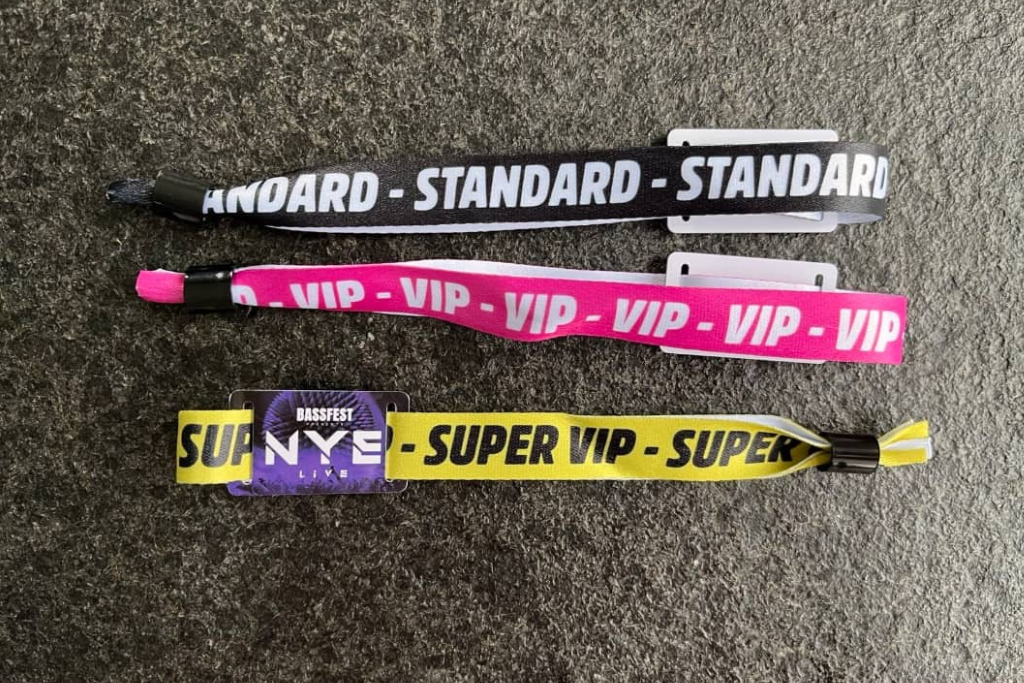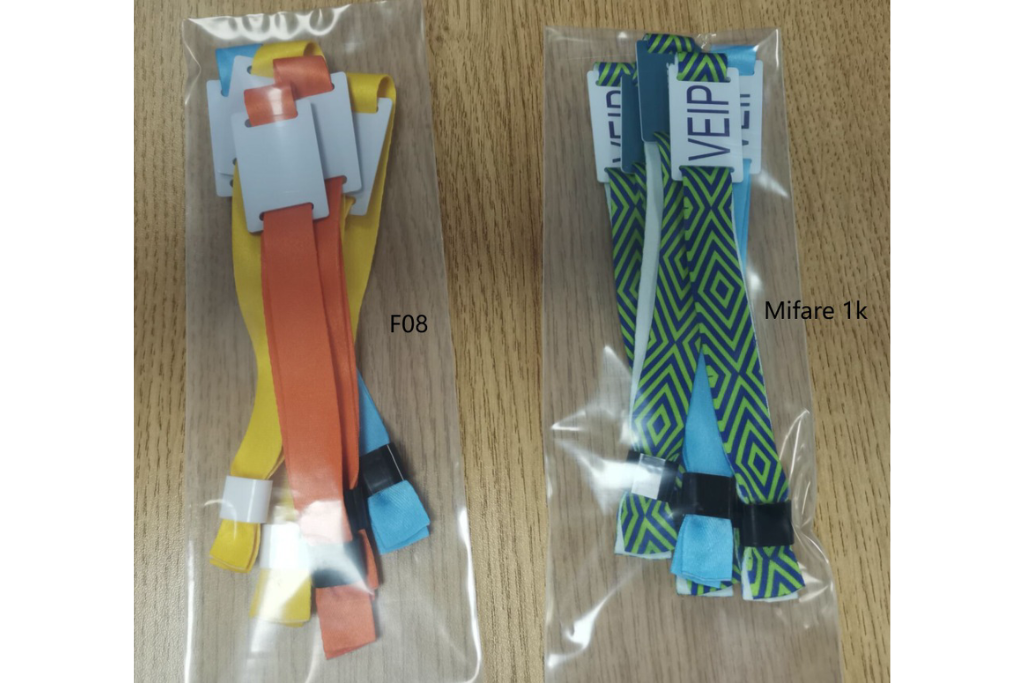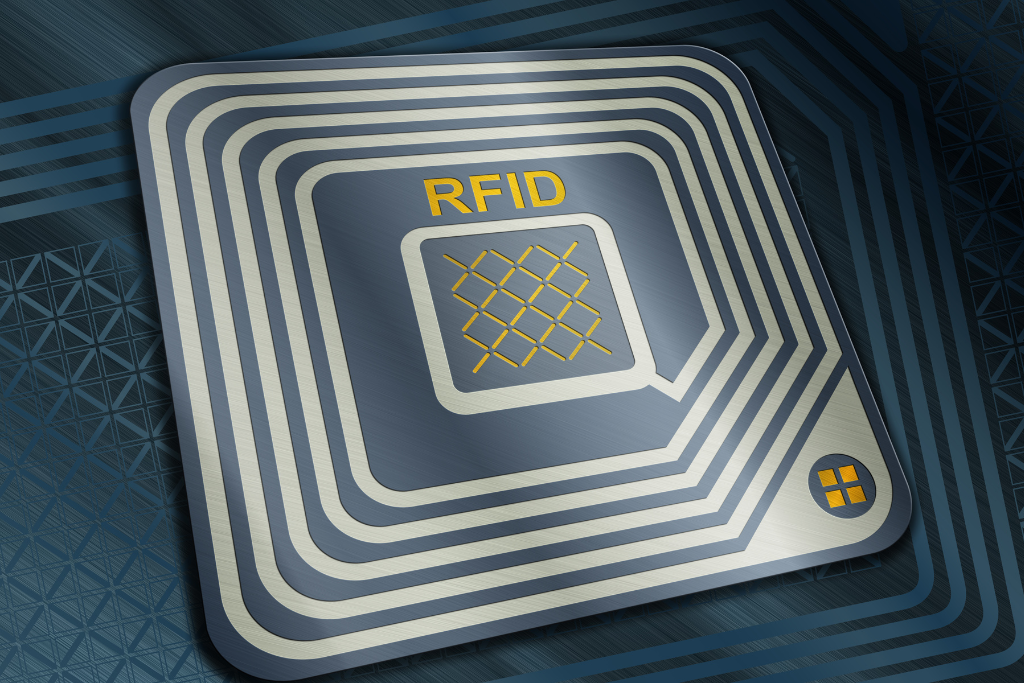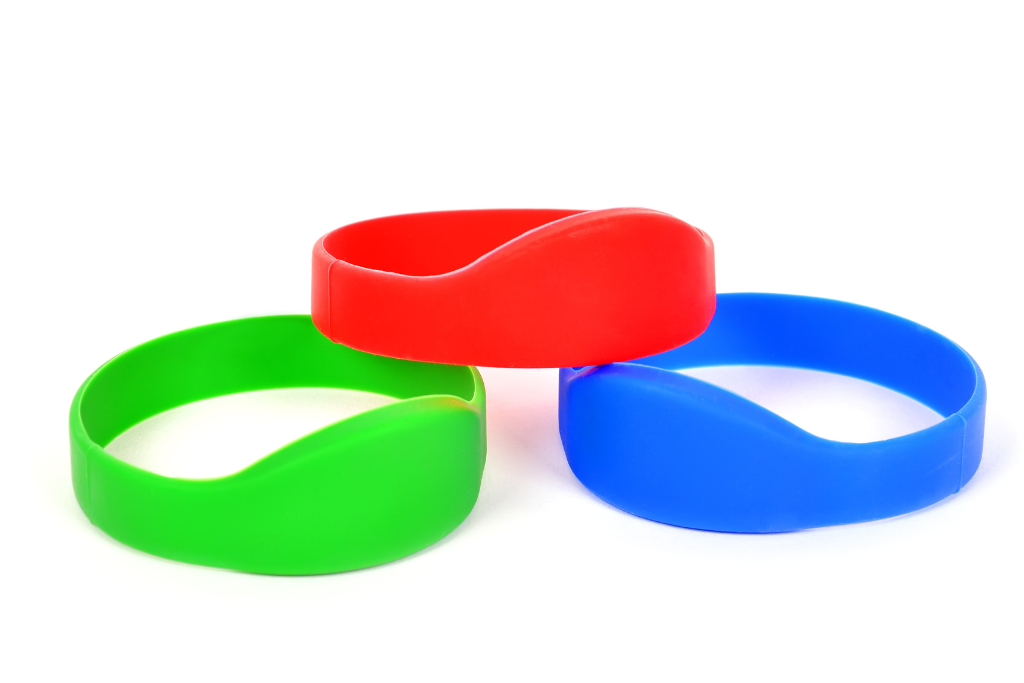“Have you ever wondered, ‘How do RFID wristbands work?’
Exploring the world of RFID wristbands in the UK?
Our beginner-friendly guide demystifies how these innovative devices work, opening doors to a realm of efficiency and advanced technology. In the bustling landscape of the UK’s events, healthcare, and security sectors, RFID (Radio-Frequency Identification) wristbands are becoming increasingly prominent.
These wristbands are not just a trend; they’re transforming how we handle access control, make payments, and manage data, simplifying complex systems into seamless interactions.

This guide is crafted for those new to RFID technology, offering a clear and concise understanding of how RFID wristbands function and their burgeoning role in various industries.
Whether you’re planning a festival, own a nightclub, manage a healthcare facility, or are looking to enhance your business’s security measures, this introduction to RFID wristbands will provide you with the essential knowledge to get started.
Explaining RFID Wristband Technology
The Basics of RFID in Wristbands
Radio-Frequency Identification (RFID) in wristbands is a groundbreaking technology that combines the convenience of wrist-worn accessories with advanced data transmission capabilities.
In essence, RFID wristbands contain small electronic devices equipped with a chip and antenna. These components work together to store and transmit data via radio waves. Primarily used in events, healthcare, and access control, RFID wristbands offer a seamless and secure way to manage information and transactions.
The Working Mechanism of RFID Wristbands
RFID wristbands operate by interacting with RFID readers. The reader emits radio waves, which activate the chip within the wristband. Once activated, the chip transmits data back to the reader.
This process occurs within seconds and without any physical contact, allowing for swift and efficient data exchange. The data stored on these chips can range from identification details to transactional information, enabling various applications like event access control, cashless payments, and social media integration.

Types of RFID Wristbands Available in the UK
In the UK market, there are primarily two types of RFID wristbands that stand out for their durability and versatility, supplied by Web Products Direct: Silicone RFID Wristbands and Fabric RFID Wristbands.
Watch our expert video on how RFID wristbands work.
How Do Festival Wristbands Work? Unveiling the Role of RFID in Modern Festivals
As we navigate through the diverse applications of RFID technology, it becomes evident how pivotal this innovation has become in various sectors, especially in the vibrant world of festivals. Let’s explore the multifaceted role of RFID wristbands in transforming festival experiences.

Transforming Entry and Interaction: The Multifunctionality of RFID Wristbands
RFID wristbands are redefining the traditional festival scene with their versatile functionalities:
- Streamlined Entry: Embrace the end of paper tickets and lengthy queues. RFID wristbands provide rapid, secure access to festival grounds, slashing wait times and virtually eliminating the risk of ticket fraud. This seamless entry system not only enhances the attendee experience but also streamlines the admission process for organizers.
- Cashless Convenience: Transform your festival experience with the cashless ease of RFID wristbands. These high-tech bands link directly to your payment methods, acting as a virtual wallet. Indulge in food, drinks, and merchandise purchases with a simple tap of your wrist, offering a level of convenience and security unmatched by traditional payment methods.
Social Media Synergy: Witness the fusion of RFID technology with social media. Modern festivals are harnessing the power of RFID wristbands to connect attendees with digital platforms. Check-ins, experience sharing, and interactions with digital installations become effortless, enriching the social aspect of festivals.
Ensuring Safety and Enhancing Security
The integration of RFID wristbands goes beyond convenience, playing a crucial role in the safety and security at festivals:
- Effective Crowd Management: With RFID technology, crowd size and movement are meticulously monitored. This capability is key in preventing overcrowding, a common safety concern at large events.
- Rapid Response to Lost Wristbands: The nightmare of losing a wristband turns into a minor hiccup with RFID technology. Lost or stolen wristbands can be quickly deactivated and replaced, safeguarding personal information and any associated funds.
- Emergency Preparedness: In critical situations, RFID wristbands can be instrumental in efficient crowd management and safe evacuation, ensuring a higher level of safety for attendees.
Commitment to Sustainability and Durability
In an era where environmental impact is paramount, RFID wristbands at festivals are designed to be both durable and sustainable. Crafted to endure diverse weather conditions and the wear and tear of multi-day festivals, Our personalised silicone and fabric wristbands are made from materials that are eco-friendly and recyclable.

Paving the Way for Future Innovations
As we look to the future, RFID wristbands are set to break new ground:
- Biometric Integration: Envision wristbands not just as entry passes but as personalized security identifiers, using biometrics to add an extra layer of security and personalization.
- Advanced Data Analytics: Future RFID wristbands could offer deeper insights into attendee preferences and behaviors, enabling organizers to tailor experiences like never before.
In summary, RFID wristbands are not just a technological advancement; they represent a paradigm shift in how festivals are experienced, managed, and enjoyed. They embody a blend of convenience, security, and innovation, paving the way for a more interactive and safe festival environment.
How to Set Up an RFID System: Insights from Web Products Direct
Unravelling the Mystique of RFID Technology
Contrary to common misconceptions, setting up an RFID (Radio-Frequency Identification) system is more than just the ‘magic’ of the tags. It involves creating a cohesive system in which RFID tags—embedded in items like wristbands or cards—interact with readers.
At Web Products Direct, we emphasize that the true magic lies in how these components work together to streamline processes.
What is RFID?
RFID stands for “radio-frequency identification.” It refers to a technology where digital data encoded in RFID tags or smart labels are captured by a reader using radio waves.
This means that a small tag, whether in a card, on a label, or in a wristband, holds a unique number transferable to a reader. Many assume that the RFID tag is the source of the magic, but in reality, it is the system, built and designed to use these numbers to complete processes.
For instance, if you want an RFID chip to open a locker, the locker’s mechanism is designed to recognize a specific set of numbers (say, from 100 wristbands you’ve purchased). When the wristband containing the RFID chip is presented in front of the lock, the lock reads the numbers, checks for a match, and if found, it unlocks.
Buying RFID Tags
RFID tags are small and thin, making them versatile enough to be integrated into cards, stickers, or wristbands. There are various types of RFID, each suitable for different applications. When purchasing a product with RFID, it’s essential to know whether you need the tags to be pre-encoded or writable.

Understanding the Options
Many systems (i.e. software created for the process) will either :
So at WPD, the software supplier will send you an Excel file with the data needed, and we simply transfer the data to each of the chips (that is the cards, the wristbands etc).
Choosing Your Supplier
Many software suppliers will say you have to use their wristbands or cards, for example. This is NOT true.
Remember, an RFID chip is simply a number. You can tell your supplier that you want to use another cheaper supplier for bands or cards.
If you have a contract, they may charge a small fee per card to send the new product supplier the data required.
Usually, the new supplier will be so much cheaper than what you are paying for the software supplier’s products, that it is well worth changing. Remember, the software supplier will have their own supplier and that they add an extra margin to the tags.
If the system simply uses the card or band’s unique number, then any chip will work as long as it is compatible.
Different Chips and Compatibility
The most commonly used chips in our experience are:
To get a quote for RFID wristbands or cards, simply contact us with the details of the chip your system uses and whether it needs to be encoded. We handle the rest, including sending out samples for testing.

Types of RFID Tags
Understanding the different types of RFID tag systems is crucial for selecting the right technology for your needs. RFID operates by transmitting data through radio waves between a tag and a reader. There are three main types of RFID tags, each with unique characteristics:
Active Tags: These tags come with their own power source, usually a battery. They can transmit information autonomously and frequently, without needing to be in close proximity to a reader. Active tags are typically used in situations where longer read ranges or larger memory capacities are required.
Passive Tags: Unlike active tags, passive tags do not have their own power source. Instead, they draw power from the reader’s radio waves. When a passive tag comes into the range of a reader, it harnesses the reader’s energy to power up and transmit its data. These tags are smaller, less expensive, and are widely used in applications like retail inventory tracking, race timing, and access control.
Battery-Assisted Tags: These are a hybrid of active and passive tags. They contain a small battery that powers the tag’s chip, making it easier for the reader to detect the tag. However, they only activate and communicate when they come in close proximity to a reader. This type of tag is often used in scenarios where a stronger signal and longer read range than what passive tags offer are needed, but where constant active transmission is not necessary.
Each of these types of RFID tag system has its own set of advantages and is suited for different applications.
At Web Products Direct, we can help you determine the best type of RFID system for your specific needs, ensuring efficiency and effectiveness in your operations.
Testing Compatibility
It’s easy to check if our chips work with your system. We send out samples free of charge for testing. We also provide all the disposable products you may need, including cards, labels, fabric wristbands, and silicone wristbands.
Starting from Scratch?
If you do not currently have an RFID system but are interested in one, we can assist. While we don’t write software, we can supply the RFID products and readers. Our experts can guide you in finding a software supplier who will write the program for your readers.
By choosing us, you benefit from both a cost-effective and trusted supplier for disposable RFID products and a connection to a software supplier without the obligation to buy their overpriced disposables.
Assessing the Value of RFID
While the initial cost of RFID technology can be high, the long-term savings are significant compared to traditional methods like manual key management. The investment pays off over the medium to long term.
If you have a project in mind, contact us for a discussion. We offer impartial advice, free from kickbacks from software suppliers, to help you move forward with the best RFID solutions.
Unlocking the Secrets: The Final Word on How do RFID Wristbands Work
In summary, this guide has aimed to thoroughly answer the question, “How do RFID wristbands work?”
From the basic mechanics of RFID technology to the nuances of different types of wristbands and systems, we’ve explored the various aspects that make RFID wristbands a revolutionary tool in the UK.

With their vast applications in events, healthcare, and security, these wristbands are not just a technological advancement but a leap towards smarter, more efficient management and interaction systems.
Whether you’re taking your first steps in the world of RFID or looking to integrate these solutions into your business, Web Products Direct is here to provide the expertise and quality products you need.
Embrace the future of technology with confidence, knowing you have a comprehensive understanding of RFID wristbands and their incredible potential.
FAQ
Storage capacity is an important aspect of the functionality of the RFID wristbands. The biggest passive tags can store a maximum of 3.72 kB of data – enough to store a name, address, credit card number and birth date; any other basic identifying informaion needs to be tracked.
Ultra-high frequency RFID tags can store as much as 8 kB of information and are commonly reserved for the aerospace sector. With wristbands and ordinary access control systems, RFID tags are usually 3 kB or smaller and don’t store sensitive data like credit card numbers.
Often, you will find things like ID credentials, vouchers, purchasing credits and social media integration on an RFID tag. That way, when you cross a checkpoint, you can automatically have your social media updated. In hotels, RFID can even replace room access key cards.
The majority of RFID wristbands operate at high frequency and cannot be tracked actively due to their limited range. But an RFID system can be used to trace an individual’s movements by pinpointing their last known location; the most recent checkpoint they passed can be identified, and they can be searched for near that area. For events at venues, RFID wristbands are best deployed for use as contactless payment devices and access control.
There is no need for a line of sight or physical contact for communication between the tag and reader. But range is limited, depending on the operating frequency:
- Low Frequency (125-134 kHz) – very short range, restricted to just a few centimetres and limited memory storage. Data transmission speeds are low, and only a small number of tags can be read at once.
- High Frequency (13.56 MHz) – range of a few inches, but larger memory capacity and higher data transfer rates.
- Ultra-High Frequency (433 MHz & 856-960 MHz) – long range, up to 70 feet, with large memory capacity and high transfer rates.
At large events, most RFID wristband systems need to operate at a high frequency using passive tags to identify patrons.
